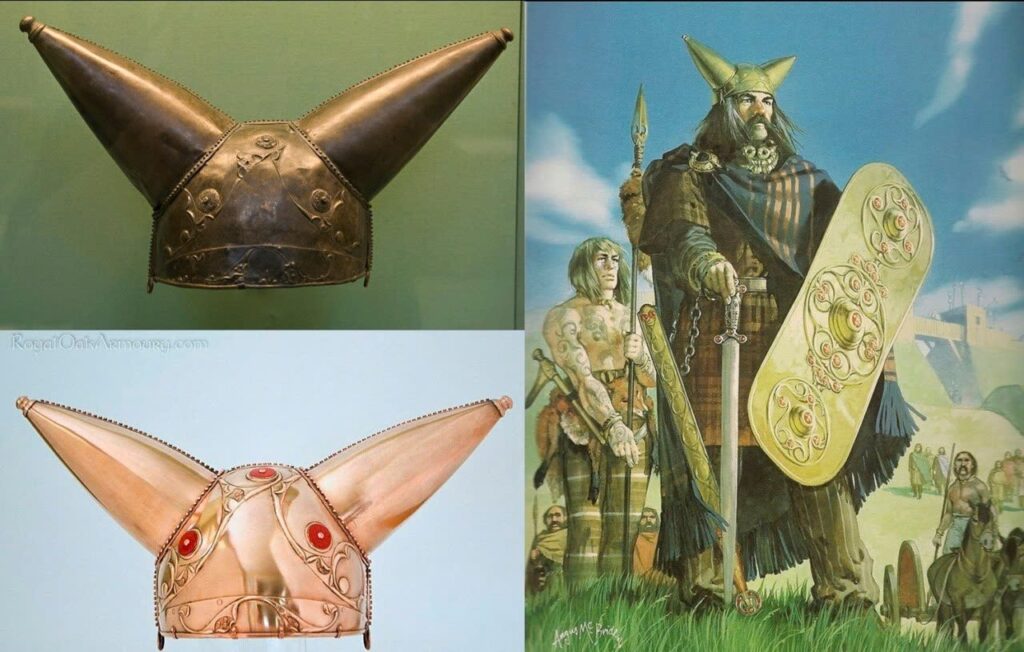The Unearthing of a Celtic Masterpiece
In the murky waters of the River Thames, near the iconic Waterloo Bridge, an extraordinary discovery was made in 1868 that would captivate historians, archaeologists, and the public for generations to come. As workers from the Port of London Authority dredged the riverbed, they unearthed a peculiar object encrusted with the patina of ages – the Waterloo Helmet, a remarkable artifact from the Iron Age that has since become a treasured piece of Britain’s cultural heritage.

A Masterpiece of La Tène Art
The Waterloo Helmet is a stunning example of Celtic craftsmanship, crafted from two pieces of bronze that have been expertly riveted together. Its most striking feature is the pair of straight horns adorning the top, each tipped with decorative knobs. The helmet’s surface is adorned with intricate repoussé decorations, hammered from the inside out, showcasing the exceptional skill of its ancient creators.
This ceremonial helmet is a true rarity among Iron Age artifacts. It is one of only three Iron Age helmets ever found in England, and the only horned helmet from that era discovered in Europe. Unlike its counterparts, the Meyrick and Canterbury helmets, the Waterloo Helmet’s unique horned design sets it apart, making it a true masterpiece of La Tène art.

From Riverbed to Museum Treasure
Despite its warrior-like appearance, the thin bronze construction of the Waterloo Helmet suggests that it was not meant for battle. Experts believe it was likely used in ceremonies or perhaps adorned a statue. The small size of the helmet has led to speculation that it may have been an offering to the river gods, intentionally deposited in the Thames.
The helmet’s journey from the riverbed to the British Museum has captivated the public imagination. In 2014, master craftsman Jeffrey Hildebrandt successfully recreated the helmet, offering valuable insights into ancient metalworking techniques. The original helmet has been featured in major exhibitions, including “Celts: Art and Identity” at the British Museum and the National Museum of Scotland, where it has continued to inspire awe and wonder.
A Window into the Past
The Waterloo Helmet stands as a testament to the artistry and cultural richness of Iron Age Britain. Its discovery not only provides a tangible link to our ancient past but continues to inspire curiosity and wonder about the people who created such remarkable objects two millennia ago. As it sits in the British Museum today, the Waterloo Helmet invites us to ponder the mysteries of ancient Celtic culture and the extraordinary stories that lie beneath the surface of our modern world.
The Enduring Legacy of the Waterloo Helmet
The Waterloo Helmet’s significance extends far beyond its physical presence. It has become a symbol of the enduring legacy of Iron Age Britain, a testament to the skill and artistry of its ancient inhabitants. The helmet’s unique design and intricate decorations have captivated the imagination of scholars and the public alike, sparking ongoing research and exploration into the cultural and technological achievements of the Celts.

Moreover, the helmet’s discovery has had a profound impact on our understanding of Iron Age Britain. The fact that it was found in the River Thames suggests that it may have held a ritual or ceremonial significance, offering insights into the religious and cultural practices of the time. The helmet’s small size has also led to speculation about its intended use, whether as an offering to the river gods or as a decorative element on a statue or other structure.
As we continue to study and appreciate the Waterloo Helmet, we are reminded of the rich and vibrant history that lies beneath the surface of our modern world. This extraordinary artifact serves as a window into the past, allowing us to glimpse the artistry, ingenuity, and cultural traditions of the Iron Age Celts. Its enduring legacy is a testament to the power of archaeological discovery to captivate the human imagination and deepen our understanding of our shared heritage.
Conclusion: Unlocking the Secrets of the Waterloo Helmet
The Waterloo Helmet’s journey from the murky depths of the River Thames to the hallowed halls of the British Museum is a story that continues to captivate and inspire. This remarkable artifact, with its striking horned design and intricate repoussé decorations, is a true masterpiece of Celtic craftsmanship, offering a glimpse into the artistry and cultural richness of Iron Age Britain.

As we continue to study and appreciate the Waterloo Helmet, we are reminded of the countless untold stories that lie buried beneath the surface of our modern world. This extraordinary discovery serves as a testament to the power of archaeology to unlock the secrets of the past and connect us to the rich tapestry of human history.
Whether you are a historian, an artist, or simply a curious observer, the Waterloo Helmet invites you to embark on a journey of discovery, to unravel the mysteries of ancient Celtic culture, and to marvel at the enduring legacy of this remarkable artifact. So let us embrace the wonder and fascination that this unexpected find has inspired, and continue to explore the extraordinary stories that lie waiting to be uncovered in the depths of our shared past.

